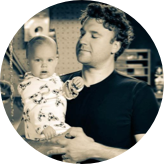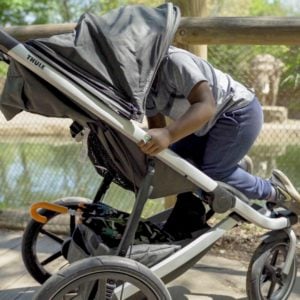A guide to baby sleep
Ah, sleep.
You want more, your baby needs more.
In fact, did you know healthy sleep in babies:
- Is important to brain development and memory consolidation
- Sets the stage for being a good sleeper for life
- leads to lower levels of postpartum depression
- And, much more
(Source: Nanit)
So, yeah, teaching your baby how to sleep is important.
And, yes, sleep is a learned skill. When we interviewed Dr. Natalie Barnett, PhD for our course on baby sleep, Baby Sleep School, she had these comforting words to say:
All babies can learn how to sleep.
Dr. Natalie Barnett, PHD
But, it sure doesn’t feel that way sometimes at 3 AM …
So, how can you get your baby to sleep, get your baby to sleep in a crib, and, when it’s time, get your baby to sleep through the night?
Read on, you’re in the right place …
In this guide, we’ll cover the following (click a link to skip to a section):
The basics of safe sleep for babies
Set up your nursery for sleep success
How to put a baby to sleep, fast
How to put a newborn to sleep
How to get a baby to sleep in a crib
How to get your baby to sleep through the night
Myths, misconceptions, and and baby sleep FAQs with Dr. Jacqueline Winkelmann
The basics of safe sleep for babies
At Fathercraft, we’re borderline fanatical about safe sleep for babies. If you want to go deep on this subject, we’ve written a full-length guide to safe sleep, and reducing the risk of SIDS and SUID. You can find that here. In this post, we’re going to cover the basics.
When it comes to safe sleep, we leverage only rock-solid sources. The following are best practices from the American Academy of Pediatrics and The CDC.
There are a few risks it’s important to know about and reduce for when it comes to baby sleep:
SIDS (Sudden Infant Death Syndrome). Occurs when, after an investigation is conducted, the cause of death cannot be determined (i.e. not accidental strangulation and suffocation). SIDS is part of a larger family of sleep-related infant deaths labeled SUID:
SUID (Sudden Unexpected Infant Death). Includes accidental strangulation and suffocation, unknown causes, and SIDS.
Falls. Babies not sleeping in a safe place (a safe crib or certain bassinets) can be subject to falls.
So, how to reduce risk of these things? Here’s a basic checklist:
- Babies should sleep only in a crib or bassinet
- This crib or bassinet should be manufactured after June 28th, 2011, according to the CPSC (stricter guidelines were put in place then)
- It should also be evaluated for proper working order, ensuring bars are no more than 2 3/8 inches apart, and checked regularly for loose parts
- Not all bassinets are safe.
- Place your baby on her back to sleep, every time
- No stuffed animals, blankets, or other loose objects in the crib for the first year
- Pajamas should have a snug fit
- Swaddles and sleep sacks should be properly adjusted to ensure they do not cover a baby’s face, and arms should be swaddled out when your baby can roll over
- Put your baby’s crib or bassinet in your room for the first 6 months
- Don’t use crib bumpers or sleep positioners
- Crib mattress should be firm and flat with only a tightly-fitting fitted sheet
- Don’t expose your baby to secondhand or even thirdhand smoke
That’s a lot and you should go deep here. More in this post.
Set up your nursery for sleep success
Getting your baby to sleep well starts with her sleep environment—the characteristics of the place your baby is sleeping. This includes the crib or bassinet where she’s sleeping, but also things about the room she’s in.
The American Academy of Pediatrics recommends that babies sleep in their parents’ room for at least the first 6 months of life.
Let’s start with the most important element of your baby’s sleep environment: the crib. In this excerpt from Baby Sleep School, Dr. Natalie Barnett, PhD. describes how to set up your crib for safety and success:
So, your baby should be in a full-sized crib by 4 months, that crib needs to be empty, and your baby can sleep in a bassinet from birth if you like.
Other nursery considerations (or considerations about your room for the first 6 months:
- Your baby should sleep in the dark (so should you, by the way). So, blackout curtains, no fancy but bright night-lights.
- Temperature should ideally be between 68 and 72 degrees, but consistency is important too if you’re thinking about a few degrees warmer or have trouble cooling your place down that much in the summer.
- Crib should be positioned away from windows, nothing should be hanging above the crib.
- No cords should be within 3 feet of your baby’s crib.
How to put a baby to sleep, fast
You may have in your head the vision of an elaborate, complex, and lengthy bedtime routine for your baby.
And a bedtime routine is important. Here’s Dr. Natalie again on the importance of routine:
But here’s the thing: a bedtime routine does not need to be long. Think 15 minutes. Again here, consistency is key. Whether you read a story, sing a lullaby, or do an ancient Mayan sleep dance (ok not a thing but it sounds nice), the key is to do the same thing each night.
The other important thing to keep as consistent as possible: time you’re putting your baby to bed. While you’re baby won’t have as much of a routine for the first couple months, after that you’ll want to keep bedtime as consistent as possible, and ideally between 6 and 8 PM to match your baby’s circadian rhythm.
Myth, debunked: putting your baby to bed later in the evening DOES NOT help her sleep later in the morning.
Why are we talking about routine in this section about getting a baby to sleep fast? Because routine is key. Routine signals to your baby it’s time to go to sleep. And, routine relaxes your baby so you won’t need to spend hours rocking her every single night.
It’s also worth noting that this is all interconnected. Setting up your baby’s sleep environment for success will also help her fall asleep faster.
How to put a newborn to sleep
One of the important and comforting things Dr. Barnett told us was that you can’t make mistakes when it comes to how you put a newborn baby to sleep (other than not following safe sleep guidelines, of course).
Many parents worry that if you want to hold your newborn while she falls asleep you’ll “spoil her” or create sleep dependencies. In reality, you don’t need to worry about this for the first couple months.
You’ll find your newborn strongly signals when she’s getting drowsy (and also, newborns sleep for 16-18 hours a day, so she will sleep A LOT. After feedings, after ‘playing’ for a bit … you name it, if your newborn is looking tired, it’s probably time for a nap.
It’s also worth noting that newborns do not produce melatonin for about the first 3 months, so a typical night/day circadian rhythm may not be established right away. But, don’t worry, it will!
How to get a baby to sleep in a crib
First thing’s first: it’s safe (and safer than many options) for your baby to sleep in a crib from the day you bring her home from the hospital. A safe crib is safe for newborns.
But, if your baby has been sleeping elsewhere and you’re looking to transition her into a full-sized crib, here are some things to consider:
Make sure your crib is set up for safety. It might be tempting to add blankets, animals, etc to make the crib “cozier” for your baby. Do not do this, it violates SIDS & SUID risk reduction recommendations from experts.
Develop a bedtime routine. A routine that you can start when your baby is in a bassinet and then keep exactly the same when you transition her to a crib will create consistency during this period of change.
It’s ok to take it slow and ease the transition. You may experiment starting with naps, or starting your baby in the crib when you put her down in the evening (she’s likely to most tired then).
Prepare yourself as this transition may be hard. You may need to be strong and let your baby “cry it out”, at least a bit, during this transition.
Your pediatrician can help. Remember, your pediatrician is a great resource; this transition is a great topic for discussion in your next visit.
How to get your baby to sleep through the night
“Sleeping through the night” is something parents of newborns and babies everywhere dream about. Or, more accurately, daydream about when they’re not sleeping.
A few things that are really important background info as you’re thinking about this milestone.
- Most babies are not biologically ready to sleep through the night until at least 3 months of age, and likely later than that.
- “Sleeping through the night” is generally definite as a continuous 6 hour stretch of sleep at night, so it’s not like your baby will suddenly sleep from 7 to 7 when she ‘sleeps through the night’
- Readiness to sleep through the night is a good topic to discuss with your pediatrician.
- Your baby needs a certain number of calories during a 24-hour period, so a baby who feeds more during daytime hours is more likely to be able to sleep through the night. However it’s a myth that you should try everything you can to get your baby to have a big feeding right before bed.
So, when you’ve got the evidence to suggest your baby is biologically ready to sleep through the night, and you’re ready, you can give it a try. It’s possible to ‘give it a try’ by giving your baby a few minutes to try and self-soothe before you respond to her cry in the middle of the night. You may find that she is able to put herself back to sleep, and get herself out of the habit of using a feeding as a soothing method. This is the method Dr. Barnett suggested starting with when we spoke with her for our Baby Sleep School course.
You may find that you need to use a sleep training methodology in order to get your baby to sleep through the night. If you do, it’s a good idea to educate yourself on the different methods and pick one that works for you, your partner, and your baby.
Finally, it’s worth noting that everything we’ve been talking about in this guide applies here too: a great nursery setup, bedtime routines, and more will all help your baby sleep through the night.
Myths, misconceptions, and FAQs about baby sleep
There are a ton of myths out there about baby sleep, and it can be useful to hear from the experts on what’s really going on. That’s why we interviewed Dr. Jacqueline Winkelmann, a pediatrician, the former Chief of Staff at Children’s Hospital of Orange County, and the medical advisor to Miku, one of our favorite baby monitors on misconceptions, plus a whole lot more in our Q&A on baby sleep:
Well, that’s it for our Ultimate Guide to Baby Sleep. We hope you enjoyed!








